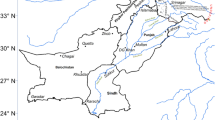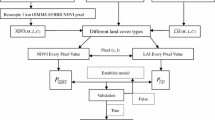Abstract
The sustainability of the global savanna ecosystem is currently under threat from climate and anthropological change. Despite the immense threats, the existence of the savanna ecosystem is undervalued and understudied. This study examined the dynamics of the savanna ecosystem in the southern part of Southeast Asia (SEA) using MODIS leaf area index (LAI) data (MOD15A3H) with 500-m spatial resolution and 4-day data, from 2002 to 2020. The annual phenological metrics comprising the start of season (SOS), end of season (EOS), length of season (LOS), rate of greening, rate of browning, and the maximum peak values were derived from the daily interpolated data using the spline function. Additional oscillation and trend analysis using empirical ensemble decomposition methods (EEMD) was conducted to derive the nonlinear trend dynamics of the savanna ecosystem in East Nusa Tenggara (ENT). We found that the SOS at the Savanna ecosystem in SEA is 253.76 ± 2.1 days, the EOS is 161.12 ± 4.0 days, and the average LOS is 170.68 ± 6.5 days. The rainfall variabilities can explain around 35% of the variability in the LAI of the savanna ecosystem. Our EEMD analysis captured the decreasing LAI trend, showing a net change between 2002 and 2015 from 1.08 LAI units (scale of 10−2) to − 0.17 LAI units (scale of 10−2) from 2015 onwards. The result indicated a declining trend of LAI values of savanna ecosystem in ENT, thus requiring further monitoring to ensure the sustainability of this ecosystem.







Similar content being viewed by others
References
Andela N, Van Der Werf GR (2014) Recent trends in African fires driven by cropland expansion and El Niño to La Niña transition Nature. Clim Change 4:791–795
Arjasakusuma S, Yamaguchi Y, Hirano Y, Zhou X (2018) ENSO- and rainfall-sensitive vegetation regions in Indonesia as identified from multi-sensor remote sensing data. ISPRS Int J Geo-Inf 7:103
Atkinson PM, Jeganathan C, Dash J, Atzberger C (2012) Inter-comparison of four models for smoothing satellite sensor time-series data to estimate vegetation phenology. Remote Sens Environ 123:400–417
Betancourt JL et al (2005a) Implementing a US national phenology network. Wiley Online Library
Betancourt JL et al (2005b) Implementing a US national phenology network. Trans Am Geophys Union 86:539–539
Bolton DK, Gray JM, Melaas EK, Moon M, Eklundh L, Friedl MA (2020) Continental-scale land surface phenology from harmonized Landsat 8 and Sentinel-2 imagery. Remote Sens Environ 240:111685
Bórnez K, Descals A, Verger A, Peñuelas J (2020) Land surface phenology from VEGETATION and PROBA-V data Assessment over deciduous forests. Int J Appl Earth Observ Geoinf 84:101974
Brown ME, de Beurs K, Vrieling A (2010) The response of African land surface phenology to large scale climate oscillations. Remote Sens Environ 114:2286–2296
Brown TB et al (2016) Using phenocams to monitor our changing Earth: toward a global phenocam network. Front Ecol Environ 14:84–93
Cai Z, Jönsson P, Jin H, Eklundh L (2017) Performance of smoothing methods for reconstructing NDVI time-series and estimating vegetation phenology from MODIS data. Remote Sens 9:1271
Chidumayo E (2001) Climate and phenology of savanna vegetation in southern. Afr J Vegetation Sci 347–354
Clinton NE, Potter C, Crabtree B, Genovese V, Gross P, Gong P (2010) Remote sensing–based time‐series analysis of cheatgrass (Bromus tectorum L.). Phenol J Environ Qual 39:955–963
de Beurs K, Henebry GM (2004) Land surface phenology, climatic variation, and institutional change: analyzing agricultural land cover change in Kazakhstan. Remote Sens Environ 89:497–509
de Beurs KM, Henebry GM (2010) Spatio-temporal statistical methods for modelling land surface phenology. Phenol Res 177-208
Delbart N, Le Toan T, Kergoat L, Fedotova V (2006) Remote sensing of spring phenology in boreal regions: a free of snow-effect method using NOAA-AVHRR and SPOT-VGT data (1982–2004). Remote Sens Environ 101:52–62
Didan K, Munoz AB, Solano R, Huete A (2015) MODIS vegetation index user’s guide (MOD13 series) University of Arizona: Vegetation Index and Phenology Lab
Dunn AH, de Beurs KM (2011) Land surface phenology of North American mountain environments using moderate resolution imaging spectroradiometer data. Remote Sens Environ 115:1220–1233
Ebata M, Tateishi R (2001) Phenological stage monitoring in Siberia by using NOAA/AVHRR data. In: 22nd Asian Conference on Remote Sensing. p 9
Fensham R, Fairfax R, Archer S (2005) Rainfall, land use and woody vegetation cover change in semi‐arid Australian savanna. J Ecol 93:596–606
Filippa G et al (2016) Phenopix: AR package for image-based vegetation phenology. Agric Forest Meteorol 220:141–150
Fisher JI, Mustard JF, Vadeboncoeur MA (2006) Green leaf phenology at Landsat resolution: scaling from the field to the satellite. Remote Sens Environ 100:265–279
Forkel M, Wutzler T (2015) greenbrown—land surface phenology and trend analysis A package for the R software Version 2:15
Friedl M, Sulla-Menashe D (2015) MCD12Q1 MODIS/Terra+ aqua land cover type yearly L3 global 500m SIN grid V006 NASA EOSDIS Land Processes DAAC 10
Funk C et al (2015) The climate hazards infrared precipitation with stations—a new environmental record for monitoring extremes. Sci Data 2:1–21
Furley P (1994) Savanna formations: ecology and environment. Prog Phys Geogr 18:276–294
Guo B, Chen Z, Guo J, Liu F, Chen C, Liu K (2016) Analysis of the nonlinear trends and non-stationary oscillations of regional precipitation in Xinjiang Northwestern China, using ensemble empirical mode decomposition. Int J Environ Res Public Health 13:345
Hawinkel P, Swinnen E, Lhermitte S, Verbist B, Van Orshoven J, Muys B (2015) A time series processing tool to extract climate-driven interannual vegetation dynamics using ensemble empirical mode decomposition (EEMD). Remote Sens Environ 169:375–389
Helske J, Luukko P (2018) Rlibeemd: ensemble empirical mode decomposition (EEMD) and its complete variant (CEEMDAN), 1.4.1 edn
Henebry GM, de Beurs KM (2013) Remote sensing of land surface phenology: a prospectus. In: Phenology: an integrative environmental science. Springer, pp 385–411
Ivits E, Cherlet M, Sommer S, Mehl W (2013) Addressing the complexity in nonlinear evolution of vegetation phenological change with time-series of remote sensing images. Ecol Ind 26:49–60
Ji F, Wu Z, Huang J, Chassignet EP (2014) Evolution of land surface air temperature trend Nature. Clim Change 4:462–466
Jones MO, Jones LA, Kimball JS, McDonald KC (2011) Satellite passive microwave remote sensing for monitoring global land surface phenology. Remote Sens Environ 115:1102–1114
Kong Y-l, Meng Y, Li W, Yue A-z, Yuan Y (2015) Satellite image time series decomposition based on EEMD. Remote Sens 7:15583–15604
Lehmann CE, Archibald SA, Hoffmann WA, Bond WJ (2011) Deciphering the distribution of the savanna biome. New Phytol 191:197–209
Ligges U, Short T, Kienzle P, Schnackenberg S, Billinghurst D, Borchers H, Weingessel A (2015) signal: signal processing. Retrieved from available at: https://CRAN.R-project.org/package=signal. Accessed 9 March 2021
Luo X et al (2018) The impact of the 2015/2016 El Niño on global photosynthesis using satellite remote sensing. Philos Trans Royal Soc B Biol Sci 373:20170409
Ma X et al (2013) Spatial patterns and temporal dynamics in savanna vegetation phenology across the North Australian Tropical Transect. Remote Sens Environ 139:97–115
Massei N, Fournier M (2012) Assessing the expression of large-scale climatic fluctuations in the hydrological variability of daily Seine river flow (France) between 1950 and 2008 using Hilbert–Huang Transform. J Hydrol 448:119–128
Melaas EK, Sulla-Menashe D, Gray JM, Black TA, Morin TH, Richardson AD, Friedl MA (2016) Multisite analysis of land surface phenology in North American temperate and boreal deciduous forests from Landsat. Remote Sens Environ 186:452–464
Molyneux N, Da Cruz GR, Williams RL, Andersen R, Turner NC (2012) Climate change and population growth in Timor Leste: implications for food security. Ambio 41:823–840
Moulin S, Kergoat L, Viovy N, Dedieu G (1997) Global-scale assessment of vegetation phenology using NOAA/AVHRR satellite measurements. J Clim 10:1154–1170
Moussus JP, Julliard R, Jiguet F (2010) Featuring 10 phenological estimators using simulated data. Methods Ecol Evol 1:140–150
Mu D (2018) Instantaneous rate of ice mass changes in Antarctica observed by satellite gravimetry. IEEE Geosci Remote Sens Lett 15:823–827
Nangendo G (2005) Changing forest-woodland-savanna mosaics in Uganda: with implications for conservation. In ITC
Pan N, Feng X, Fu B, Wang S, Ji F, Pan S (2018) Increasing global vegetation browning hidden in overall vegetation greening: insights from time-varying trends. Remote Sens Environ 214:59–72
Pasaribu SM (2016) Revitalizing institutions to enhance climate forecast application in East Nusa Tenggara Province Indonesia. Analisis Kebijakan Pertanian 5:239–253
Peng D et al (2017) Scaling effects on spring phenology detections from MODIS data at multiple spatial resolutions over the contiguous United States. ISPRS J Photogramm Remote Sens 132:185–198
Pennington RT, Lehmann CE, Rowland LM (2018) Tropical savannas and dry forests. Curr Biol 28:R541–R545
Qian C (2016) On trend estimation and significance testing for non-Gaussian and serially dependent data: quantifying the urbanization effect on trends in hot extremes in the megacity of Shanghai. Clim Dyn 47:329–344
Ratnam J, Sheth C, Sankaran M (2019) African and Asian savannas. In: Scogings PF, Sankaran M (eds) Savanna woody plants and large herbivores. West Sussex: Wiley, pp 25–42
Ratnam J, Tomlinson KW, Rasquinha DN, Sankaran M (2016) Savannahs of Asia: antiquity, biogeography, and an uncertain future. Philos Trans Royal Soc B Biol Sci 371:20150305
Ren H, Wang Y-L, Huang M-Y, Chang Y-L, Kao H-M (2014) Ensemble empirical mode decomposition parameters optimization for spectral distance measurement in hyperspectral remote sensing data. Remote Sens 6:2069–2083
Richardson AD, Keenan TF, Migliavacca M, Ryu Y, Sonnentag O, Toomey M (2013) Climate change, phenology, and phenological control of vegetation feedbacks to the climate system. Agric Forest Meteorol 169:156–173
Ruefenacht B (2016) Comparison of three Landsat TM compositing methods: a case study using modeled tree canopy cover. Photogramm Eng Remote Sens 82:199–211
Sang Y-F, Wang Z, Liu C (2014) Comparison of the MK test and EMD method for trend identification in hydrological time series. J Hydrol 510:293–298
Scholes R, Archer S (1997) Tree-grass interactions in savannas. Ann Rev EcolSyst 28:517–544
Schumaker L (2007) Spline functions: basic theory. Cambridge University Press
Tao F, Yokozawa M, Zhang Z, Hayashi Y, Ishigooka Y (2008) Land surface phenology dynamics and climate variations in the North East China Transect (NECT), 1982–2000. Int J Remote Sens 29:5461–5478
Twine W (2019) Socioeconomic value of savannas Savanna Woody Plants and Large Herbivores 151–179
Wu Z, Huang NE (2009) Ensemble empirical mode decomposition: a noise-assisted data analysis method. Adv Adapt Data Anal 1:1–41
Wu Z, Huang NE, Wallace JM, Smoliak BV, Chen X (2011) On the time-varying trend in global-mean surface temperature. ClimDyn 37:759–773
Yin Y, Ma D, Wu S, Dai E, Zhu Z, Myneni RB (2017) Nonlinear variations of forest leaf area index over China during 1982–2010 based on EEMD method. Int J Biometeorol 61:977–988
Zeng L, Wardlow BD, Xiang D, Hu S, Li D (2020) A review of vegetation phenological metrics extraction using time-series, multispectral satellite data. Remote Sens Environ 237:111511
Zhang X, Friedl MA, Schaaf CB (2006) Global vegetation phenology from Moderate Resolution Imaging Spectroradiometer (MODIS): evaluation of global patterns and comparison with in situ measurements. J Geophys Res Biogeosci 111
Zhang X, Friedl MA, Schaaf CB (2009) Sensitivity of vegetation phenology detection to the temporal resolution of satellite data. Int J Remote Sens 30:2061–2074
Zhang X et al (2017) Exploration of scaling effects on coarse resolution land surface phenology. Remote Sens Environ 190:318–330
Acknowledgements
The research was supported under the research grant for the lecturer of Faculty of Geography, Universitas Gadjah Mada no. 1933/UN1/FGE/SETD/M/2020. The authors also would like to thank the anonymous reviewer for the constructive comments on the manuscript.
Funding
The study was supported by the research grant for the lecturer of Faculty of Geography, Universitas Gadjah Mada no. 1933/UN1/FGE/SETD/M/2020.
Author information
Authors and Affiliations
Corresponding author
Ethics declarations
Conflict of interest
The authors declare no competing interests.
Rights and permissions
About this article
Cite this article
Arjasakusuma, S., Kusuma, S.S., Saringatin, S. et al. Assessing land surface phenology of the savanna ecosystem in Southeast Asia using Moderate Resolution Imaging Spectroradiometer (MODIS) leaf area index from 2002 to 2020 . Appl Geomat 13, 515–525 (2021). https://doi.org/10.1007/s12518-021-00368-1
Received:
Accepted:
Published:
Issue Date:
DOI: https://doi.org/10.1007/s12518-021-00368-1




